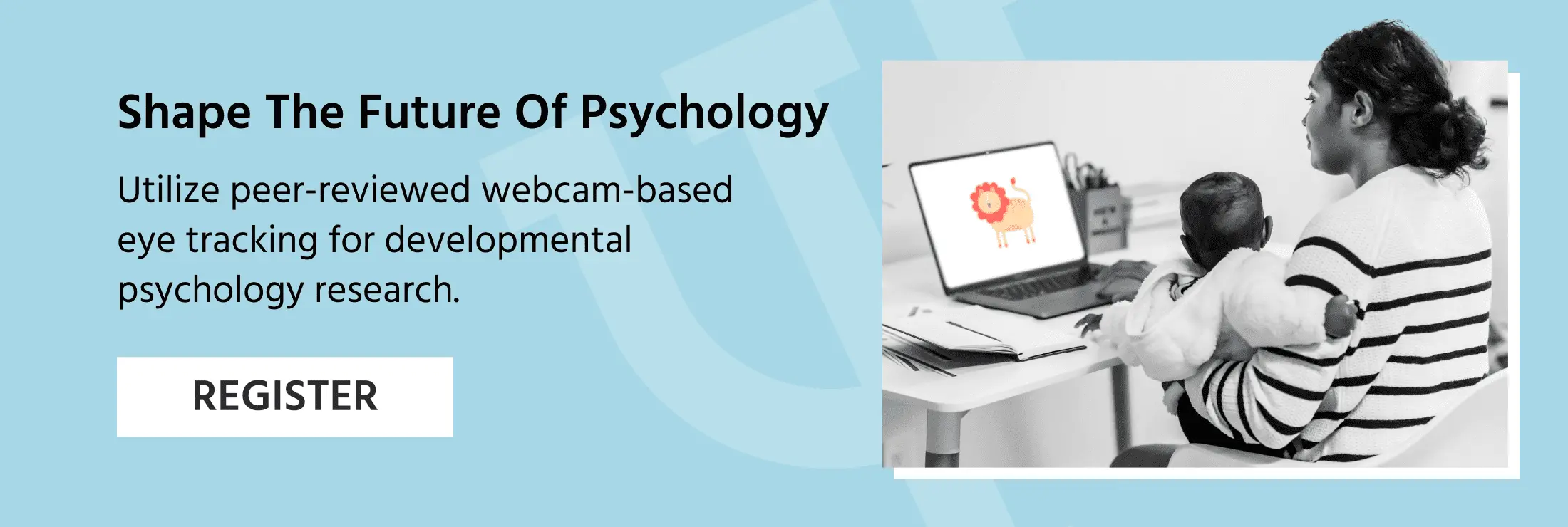
Introduction to the Preferential Looking Paradigm
The preferential looking paradigm is used in toddlers and infants that are otherwise too young to identify or make sense of either letters or pictures.
Often coupled with the head-turn preference procedure, the preferential looking paradigm is an experimental technique used specifically for studying infants and toddlers in order to assess how they orient to and understand visual and/or auditory stimuli.
Researchers are interested in the preferential looking paradigm because it helps them uncover more about the mystery of human knowledge, its origins, and the intrinsic nature of developmental psychology.
Preferential Looking Paradigm Technique
During the preferential looking paradigm test, a young participant is presented with two fields, such as a target stimuli or a flat gray area.
A popular example of a preferential looking paradigm task is to show a face as the target stimuli in one experimental field versus a jumbled features of a face that are non-sensical in the other experimental field.
Auditory Components During the Preferential Looking Paradigm Test
While the preferential looking paradigm for visual stimuli is widely known, it is also possible to use auditory stimuli with this paradigm. In fact, in the last few years, numerous psychologists have set up research methods for assessing language comprehension and early speech perception using the preferential looking paradigm.
As a technique, the prefenetial looking paradigm is popular amongst linguists studying language comprehension and development as it has been shown that comprehension begins before production. With the prefenetial looking paradigm tasks, children are not required to understand difficult commands or instructions in order to complete the tasks, thus allowing babies to demonstrate their grasp of language prior to being capable of producing words and sentences (Golinkoff et al., 2013).
Variables from the Preferential Looking Paradigm Test
Commonly used dependent variables for preferential looking paradigm include the :
- Longest look measure (LLK)
- For the distractor
- For the target
- Proportion of total looks towards the targeted stimuli (PTL)
- Time-proportion analysis
- Latency shift to target
These dependent variables are further granulated if the design includes the introduction of auditory stimuli (Luche et al., 2015).
When designing a study utilizing the preferential looking paradigm technique, it’s good practice to account for common confounds in infant and developmental research, such as: age, gender, musicality, multilingualism, caregivers age and education (Banki et al., 2022).
Measuring Responses during Preferential Looking Tasks
Task performance during preferential looking paradigms are assessed using video recording and eye tracking tools either in person at a lab or remotely via Labvanced.
A recent study by Banki et al. showed that online and in-lab eye tracking capture infants’ viewing behavior equally well, provided that a data quality step is performed. This study assessed differences based between remote and in-lab methods for measuring infants’ performance on a preferential looking paradigm task and assessed data quality, infants’ eye viewing behavior and experimental effects between the two experimental groups.
These areas of focuses included:
- Data quality: ET calibration quality, sampling frequency, missing data quantity, average task and trial duration
- Viewing behavior: Areas of Interest (AOIs) and gaze duration
- Experimental effects: higher looking time in complex vs, simple stimuli and population variability based on caregiver and education level.

Sample of an experimental block from the study by Banki et al. 2022.
In the image above, an experimental block from the study is shown representation a duration of 1m 44s. Within each block, there were two complex trials and two simple ones, a total of four. Each trial lasted for 23 seconds and was preceded by an infant-friendly fixation point (a spinning star) that lasted for 3 seconds. All participants (4-6 month old infants) viewed a total of 12 trials that were presented across three blocks. The design was such that trials would alternate between simple and complex within the block. Before the first block, a calibration step with a spinning spiral was performed.
- Read more: Researcher Interview with Dr. Anna Banki and Dr. Gabriela Markova about their experience comparing in-lab and online-based eyetracking for their infant research study.
After their analysis on the viewing behavior, data quality, and experimental effects, the researchers concluded that there was no difference between the in-lab and online studies in terms of technical difficulties or attrition rate. When data quality selected valid trials for both experimental settings, eye tracking and video data were equal across experimental settings. The researchers concluded that online eye-tracking with the preferential looking paradigm is a valuable option for this research area, recommended the data quality step, and further development in the field.
Conclusion
The preferential looking paradigm is a powerful and popular test in the world of language research and cognitive development. Researchers are interested in learning how language and cognition evolve use this paradigm combined with in-lab and online eyetracking in order to run their study.
References
Bánki, A., de Eccher, M., Falschlehner, L., Hoehl, S., & Markova, G. (2022). Comparing online webcam-and laboratory-based eye-tracking for the assessment of infants’ audio-visual synchrony perception. Frontiers in Psychology, 6162.
Delle Luche, C., Durrant, S., Poltrock, S., & Floccia, C. (2015). A methodological investigation of the Intermodal Preferential Looking paradigm: Methods of analyses, picture selection and data rejection criteria. Infant Behavior and Development, 40, 151-172.
Golinkoff, R. M., Ma, W., Song, L., & Hirsh-Pasek, K. (2013). Twenty-five years using the intermodal preferential looking paradigm to study language acquisition: What have we learned?. Perspectives on Psychological Science, 8(3), 316-339.
